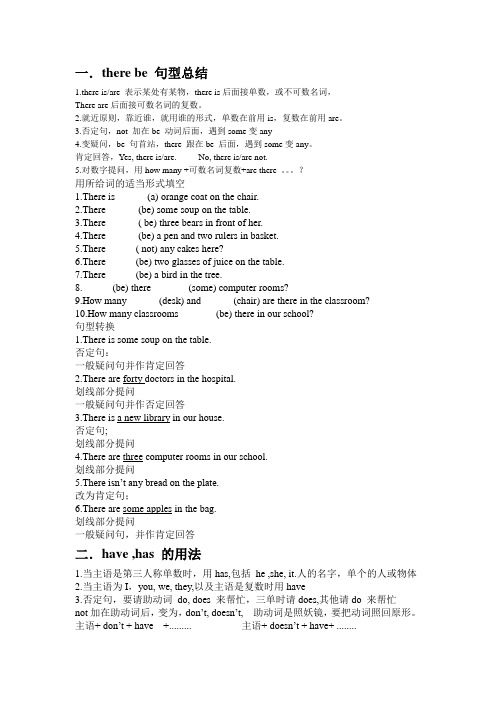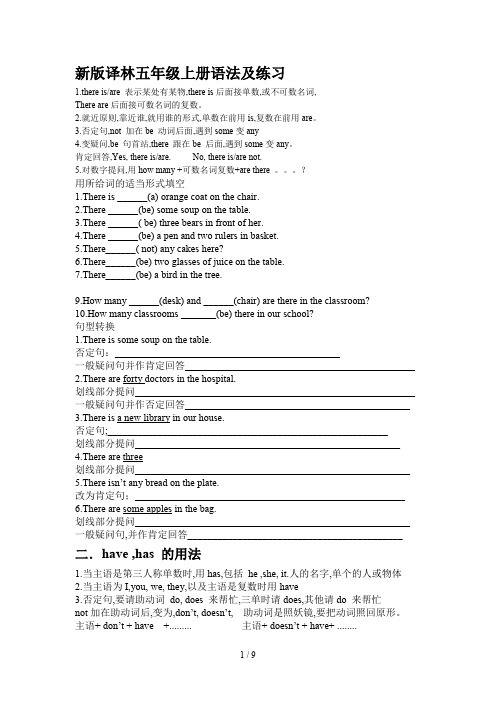完整新版译林五年级上册语法及练习
- 格式:doc
- 大小:36.87 KB
- 文档页数:9

一.there be 句型总结1.there is/are 表示某处有某物,there is后面接单数,或不可数名词,There are后面接可数名词的复数。
2.就近原则,靠近谁,就用谁的形式,单数在前用is,复数在前用are。
3.否定句,not 加在be 动词后面,遇到some变any4.变疑问,be 句首站,there 跟在be 后面,遇到some变any。
肯定回答,Yes, there is/are. No, there is/are not.5.对数字提问,用how many +可数名词复数+are there 。
?用所给词的适当形式填空1.There is ______(a) orange coat on the chair.2.There ______(be) some soup on the table.3.There ______( be) three bears in front of her.4.There ______(be) a pen and two rulers in basket.5.There______( not) any cakes here?6.There______(be) two glasses of juice on the table.7.There______(be) a bird in the tree.8.______(be) there _______(some) computer rooms?9.How many ______(desk) and ______(chair) are there in the classroom?10.How many classrooms _______(be) there in our school?句型转换1.There is some soup on the table.否定句:_____________________________________________一般疑问句并作肯定回答______________________________________________ 2.There are forty doctors in the hospital.划线部分提问________________________________________________________ 一般疑问句并作否定回答_____________________________________________ 3.There is a new library in our house.否定句;________________________________________________________划线部分提问_____________________________________________________ 4.There are three computer rooms in our school.划线部分提问_______________________________________________________ 5.There isn’t any bread on the plate.改为肯定句;______________________________________________________ 6.There are some apples in the bag.划线部分提问_______________________________________________________ 一般疑问句,并作肯定回答___________________________________________二.have ,has 的用法1.当主语是第三人称单数时,用has,包括he ,she, it.人的名字,单个的人或物体2.当主语为I,you, we, they,以及主语是复数时用have3.否定句,要请助动词do, does 来帮忙,三单时请does,其他请do 来帮忙not加在助动词后,变为,don’t, doesn’t, 助动词是照妖镜,要把动词照回原形。

江苏译林版小学五年级英语上册复习资料(含知识点、语法知识、练习题、易错题及作文)江苏译林版英语五年级上册知识点整理及练习Unit 1Goldilocksandthethreebears一、单词(默写)1.bear熊2.forest森林3.there(与be连用)有4.house房子5.soup 汤6.justright正合适7.room房间8.hard硬的9.soft柔软的10.afraid 害怕的11.their他们的12.her她(宾格)13.help救命14.beside 在……旁边15.between在……中间16.really真正地17.then然后18.find找到,发现19.infrontof在……前面二、词组(默写)1、intheforest在森林里2、abeautifulhouse一座漂亮的房子3、hungryandthirsty又饿又渴4、somesoup一些汤5、toocold/hot太冷/热6、intheroom在房间里7、toohard/soft太硬/软8、threebears三只熊9、havesomecakes吃些蛋糕10、inthekitchen在厨11、inthefridge在冰箱里12、findtheircousin 发现他们的表弟三、句型(默写)1.Thereisahouseintheforest.在森林里有一个房子。
2.Thereissomesouponthetable.在桌子上有一些汤。
3.Therearethreebearsinfrontofher.在她前面有三只熊。
4.Thissoupistoocold.这汤太冷了。
5.Whatabeautifulhouse!多么漂亮的房子!6.Sheishungryandthirsty.她是又饿又渴。
7.Bobbycannot(can’t)seeanycakesinthefridge.波比看不到冰箱里有蛋糕。
四.语法点(理解)1.Therebe句型表示“某处有某物”(1)其中thereis用于单数名词或不可数名词,如:Thereisapencilcaseintheschoolbag.Thereissomesoup/milk/tea/coffee/ juice/water/chocolate.(2)Thereare用于可数名词的复数,如:Therearesomedesksintheclassroom.(3)Therebe句型的就近原则:be动词后面如果跟的是不止一种物品,就根据离它最近的物品选用is或are.如:Therearesomepicturesandatelephone.Thereisatelephoneandsomepict ures.2.Therebe句型的否定形式:在be动词的后面加not(isnot可以缩写为isn”t,arenot可以缩写为aren”t)把some改成any。

5AU3 语法have 和 has的用法及练习一.have 和 has 的用法have/ has 表示某人有某物。
have 用于第一人称. 第二人称和第三人称复数, 如: I, you, we, they, boys ... has 只能用于第三人称单数。
如:he, she, it, Yang Ling ...二.have 和 has的句式结构1. 肯定句(1)主语(第一.二人称和第三人称复数)+have + 某物。
(2) 主语(第三人称单数)+has+ 某物。
2. 否定句(1)主语(第一. 二人称和第三人称复数)+don't+have+ 某物。
(2) 主语(第三人称单数)+doesn't+have+ 某物。
3. 一般疑问句(1) Do+ 主语(第一.二人称和第三人称复数)+have+ 某物?(2) Does+ 主语(第三人称单数)+have+ 某物?三.have 和 has 的句型变换(1)肯定句改否定句:在动词(have 或has)前加 don't 或者 doesn't, 动词用 have。
(2)肯定句改一般疑问句:在句首加助动词do或者 does,动词用 have。
小试牛刀用 have, has 填空。
1. They so me eggs and milk.2. It four legs and a big head.3. The monkey two long arms.4. My toy tiger a big body.5. Su Hai a cat. It two big eyes.6. Our English teacher big ears and long hair.7. The dog four long legs.8. We a new school.9. Jim so me coffee for breakfast.10. My father two fish.11. The girl milk and bread for dinner.12. Ben and his brother many stickers.13. The little monkey in the tree long arms.14. Their parents many friends.15. My sister a nice skirt.16.The nurses white clothes.17.He and she so me bananas.18. Look, the boy so me apples.19.Our school twelve classrooms.20.The students many books.21.Her sister a new bike.22.Their teacher some nice pictures.23.Your mother a new bike.24. Li Ming's mother big eyes.25. Jenny and Danny two black pens.26. The dog some meat in its mouth.27. The students of Class One a football.28. Mary a doll.29. They so me soup for supper.30. Our school a big library.31. I so me red ink.32. His father an old car.33. You two big eyes.34. I a new kite.35. My mother a lot of friends.36. The children some pictures.37. We some big tents.38. They a lot of books.39. My parents a dog. Your parent a dog.40. My brother a new bag. Your sister six dogs.41. Nancy a lovely cat. Helen a watch.42. Jack and Tom a toy car.43. Does it two wings?44. Our teacher an English book.45. David’s friends some nice picture books.46. Who a volleyball?47. The rabbit long ears.48. Birds big bodies.49. Elephants two big ears.50. A dog four feet. Three dogs twelve feet.51. It four legs and a small body.52. Our classroom eight windows.53. The new teacher a tin of fish.54. The student in the classroom a big bag.55. Su Hai and Su Yang a happy family.。

Unit3 Our animal friends一、have/has 的用法及练习(一)have/has的肯定陈述句基本结构为“主语+ have/has +某物.”。
当主语为第三人称单数时用has,其余人称作主语时用have。
如:You have a bag and she has a doll.你有一个包,她有一个洋娃娃。
(二)have/has的否定陈述句基本结构为“主语+ don't/doesn't have +某物”。
当主语为第三人称单数时用doesn't have,其余人称作主语时用don't have。
此句型的同义句型为“主语+ have/has no 十某物”。
如:I don't have an animal friend.= I have no animal friend我没有动物朋友。
(三)含have的一般疑问句及其答语1、—Do +主语(除第三人称单数)+ have +某物?—Yes,主语+ do./No,主语+ don't如:—Do you have a ruler?你有一把尺子吗?—Yes,I do.是的,我有。
2、—Does +主语(第三人称单数)+ have +某物?—Yes,主语+ does./No,主语+doesn't.如:—Does Mike have a dictionary?迈克有一本字典吗?—No,he doesn't,不,他没有。
(四)含have的特殊疑问句及其答语—What + do/does 十主语+ have?—主语+ have/has +某物.如:—What do you have? 你有什么?—I have a nice doll.我有一个漂亮的洋娃娃。
(五)have/has 和there be 的区别两者都表示“有”。
have/has 强调所属关系,通常放在主语之后,即“主语+ have/has 十某物”;there be强调“存在”,放在句首,即“There be 十名词+表示地点的介词短语.”。

新版译林五年级上册语法及练习1.there is/are 表示某处有某物,there is后面接单数,或不可数名词,There are后面接可数名词的复数。
2.就近原则,靠近谁,就用谁的形式,单数在前用is,复数在前用are。
3.否定句,not 加在be 动词后面,遇到some变any4.变疑问,be 句首站,there 跟在be 后面,遇到some变any。
肯定回答,Yes, there is/are. No, there is/are not.5.对数字提问,用how many +可数名词复数+are there 。
?用所给词的适当形式填空1.There is ______(a) orange coat on the chair.2.There ______(be) some soup on the table.3.There ______( be) three bears in front of her.4.There ______(be) a pen and two rulers in basket.5.There______( not) any cakes here?6.There______(be) two glasses of juice on the table.7.There______(be) a bird in the tree.9.How many ______(desk) and ______(chair) are there in the classroom?10.How many classrooms _______(be) there in our school?句型转换1.There is some soup on the table.否定句:_____________________________________________一般疑问句并作肯定回答______________________________________________ 2.There are forty doctors in the hospital.划线部分提问________________________________________________________ 一般疑问句并作否定回答_____________________________________________ 3.There is a new library in our house.否定句;________________________________________________________划线部分提问_____________________________________________________ 4.There are three划线部分提问_______________________________________________________ 5.There isn’t any bread on the plate.改为肯定句;______________________________________________________ 6.There are some apples in the bag.划线部分提问_______________________________________________________ 一般疑问句,并作肯定回答___________________________________________二.have ,has 的用法1.当主语是第三人称单数时,用has,包括he ,she, it.人的名字,单个的人或物体2.当主语为I,you, we, they,以及主语是复数时用have3.否定句,要请助动词do, does 来帮忙,三单时请does,其他请do 来帮忙not加在助动词后,变为,don’t, doesn’t, 助动词是照妖镜,要把动词照回原形。

译林版小学英语五年级上册5A语法大全完整版UNIT 1第一单元1.there be 句型there be 句型的结构为:there be+名词(短语)+地点状语。
该句型表示某地有某人或者某物。
当there be后面的名词为复数时,be动词用are;当该名词为单数或不可数名词时,be 动词用is。
(1)肯定句:There is+a/an+可数名词单数;There is+不可数名词;There are+可数名词复数。
(2)否定句:There is/are +not+在否定句中,be动词后面加not;some改为any。
(3)一般疑问句:A:Is there …? B:Yes,there is ./No,there isn’t.A:Are there …?B:Yes,there are./No,there aren’t.在疑问句中,将be动词要放在there之前;要将some改为any。
2.there be 句型的“就近原则”不管后面接多少个不同类的物品,句型都要根据离动词最近的那个名词来确定用“there is”还是“there are”。
如“公园里有一棵大树和一些花。
”就可以这样说:There is a big tree and some flowers in the park..There are some flowers and a big tree in the park.UNIT 2第二单元1.there be 的特殊疑问句How many +复数名词+are there…?回答需用“There is/are+数词”结构,或者直接用数词回答。
2.基数词和序数词表示数目和顺序的词叫做数词。
数词又分基数词和序数词,基数词表示数量,序数词表示顺序。
如:one-first two-second three-third等。
基数词后面的名词要注意单复数的变化,而序数词前一般要加the,后面跟名词单数,表示“第几”。
五年级上册语法知识+练习Unit 1 Goldilocks and the three bears知识点回顾:1.There is +可数名词单数/不可数名词---There_____ an apple on the table.---There_____some bread on the table. (常见的不可数名词:soup,juice,tea,milk,coffee,rice,bread,food,meat肉)2.There are+可数名词复数---There_____some apples on the table.3.There be 句型的________原则---There______an apple and some pears in my bag.---There______some pears and an apple in my bag.4..some用于肯定句,any用于疑问句或者否定句;a..---You can have_______cakes.b.---There aren’t_______cakes here.C.---Do you have ______cakes?5.动词/介词+宾格---There are three bears in front of ________(she).---Let ______(I)have a look.6.写宾格:I_________ we________you______they______she_______he________it________小练笔:用所给词的适当形式填空。
1.There______(be)some beds in the house.2.There______(be)some rice in the bowl(碗).3.There______(be)a desk ,a chair and a football in the room.4.There______(be)some bread and some apples on the table.5.There______(be)any books in the school bag.6.There______(be)any apple juice in the fridge.7.There______(be)an orange and three pears in the basket.8.I can see the pen between the _______(desk).9.There________(be)any food in the fridge.10.We_______(have)a new house.11.The teacher is beside_______(he).12.I’d like some______(soup).13.How many_______(bear)are there?14.I like________(cake) very much.15.—______(be)you tired?—No,I’m not.16.Let’s______(eat) some cakes,Linda.Ok!17.I like this_______(apple).18.Look,they are________(they)books.19.Here_______(be)the pie.20.My uncle______(have)a cold.21.I can see a cat beside_______(she).根据首字母提示填空。
江苏译林版英语五年级上册知识点整理及练习江苏译林版英语五年级上册知识点整理及练习U n i t1G o l d i l o c k s a n d t h e t h r e e b e a r s一、单词(默写)熊森林(与b e连用)有房子汤r i g h t 正合适房间硬的柔软的害怕的11.t h e i r他们的她(宾格)救命在……旁边在……中间真正地然后找到,发现19.i n f r o n t o f在……前面二、词组(默写)1、i n t h e f o r e s t在森林里2、a b e a u t i f u l h o u s e一座漂亮的房子3、h u n g r y a n d t h i r s t y又饿又渴4、s o m e s o u p一些汤5、t o o c o l d/h o t太冷/热6、i n t h e r o o m在房间里7、t o o h a r d/s o f t太硬/软8、t h r e e b e a r s三只熊9、h a v e s o m e c a k e s吃些蛋糕10、i n t h e k i t c h e n在厨11、i n t h e f r i d g e 在冰箱里12、f i n d t h e i r c o u s i n发现他们的表弟三、句型(默写)1.T h e r e i s a h o u s e i n t h e f o r e s t.在森林里有一个房子。
2.T h e r e i s s o m e s o u p o n t h e t a b l e.在桌子上有一些汤。
3.T h e r e a r e t h r e e b e a r s i n f r o n t o f h e r.在她前面有三只熊。
4.T h i s s o u p i s t o o c o l d.这汤太冷了。
5.W h a t a b e a u t i f u l h o u s e!多么漂亮的房子!6.S h e i s h u n g r y a n d t h i r s t y.她是又饿又渴。
新译林苏教版小学五年级上册语法总复习及练习五年级语法总复3.Let+宾格+动词原形。
4.want to do sth.想要做某事want to +动词原形5.like +动词ing。
like +名词复数。
现在分词ing规则:6.be good at+宾格/名词/名词ing①去不发音的e加ing(skating,dancing,writing)7.be动词+动词ing②只有一个元音,词尾只有一个辅音字母,8.行为动词go +动词ing双写这个辅音字母加ing.(running,swimming)9.be动词有am。
is。
are.“我用am,你用are。
XXX用于她他它。
单数is。
复数are.”10.“有”Thereis…/“有吗”Isthere…。
+可数名词单数/不可数名词。
There are /Are there+可数名词复数There be句型就近原则11.an+以a o e i u开头的单词前。
就近原则12.Play+球类。
play +the+乐器。
13.any”一些”用于否定句和疑问句。
or”或者”用于否定句和疑问句。
14.一般疑问句:be动词提前,情态动词提前,do/does提前(第三人称用does),第一人称变第二人称。
15.否认句:be动词(am is are)+not,神态动词can+ not,没有be动词和神态动词时用do。
does+notdon’t。
doesn’t)。
(第三人称用doesn’t)。
否定句第二种:名词前加no.16.主语(人/物)是第三人称单数时,陈述句中的动词+s/es,have变has。
否定句用doesn’t。
一般疑问句does提前。
第三人称单数有:he。
she。
it,一个物体,一个动物,一个人名,一个人称(father。
XXX。
sister。
brother。
XXX。
grandpa。
uncle。
…)17.+es划定规矩:①单词以s。
x。
ch。
sh,o结尾+es;②单词以子音字母+y结尾,变y为i+es(hobbies。
1、have/has的用法have和has都表示有,强调某人拥有某物。
结构:主语+have/has+某物。
have用于除第三人称单数之外所有的人称之后,has只用于第三人称之后。
We have many animal friends.She has two big eyes.2、have与there be句型的区别两者都表示“有”的含义,但用法上存在差别。
there be结构表示存在关系,主语通常是物。
have/has表示所属关系,主语通常是人。
There are many flowers in the garden.The dog has a long tail.3、have在一般疑问句中用法have在一般疑问结构:do/does+主语+have+……回答Yes,……do/does. No,……don’t/doesn’t.例:—Do they have long tails?—No,they don’t.例:—Does your sister have an animal friend?—Yes,she does.4、情态动词情态动词本身有一定的词义,表示语气的单词。
但是不能独立作谓语,只能和动词原形一起构成谓语。
情态动词用在行为动词前,表示说话人对这一动作或状态的看法或主观设想。
常用can, may, must, need, shall , will……情态动词无人称和数的变化,情态动词后面跟的动词须用原形,否定式构成是在情态动词后面加"not"。
一般疑问句,将情态动词直接提前。
I can’t play the piano.Can you play football well?5、give sb. sth.的用法give sb. sth.=give sth. to sb.意思是给某人某物Give me a hamburger,please.=Give a hamburger to me,please.一、按照要求写词1、has(原形)____________________2、do(第三人称单数形式)________2、foot(复数)___________________4、it(复数)____________________ 5、do not(缩略式)__________________6. short(反义词)_______________ 7、bodies(单数)___________________8.story(复数)_______________9、like(第三人称单数形式)__________ 10.we(宾格)_______________二、英汉互译1.一个动物朋友____________________2. there be ____________________3.两只翅膀____________________4. have a long tail _______________5.在农场____________________6. in China _____________________7.唱歌和跳舞____________________8. their bodies __________________9.会飞____________________10. no legs or arms _______________ 11.讲故事____________________12.look out____________________13.在他们后面__________________ 14.have an idea__________________三、用所给单词的适当形式填空。
一.there be 句型总结1.there is/are 表示某处有某物,there is后面接单数,或不可数名词,There are后面接可数名词的复数。
2.就近原则,靠近谁,就用谁的形式,单数在前用is,复数在前用are。
3.否定句,not 加在be 动词后面,遇到some变any4.变疑问,be 句首站,there 跟在be 后面,遇到some变any。
肯定回答,Yes, there is/are. No, there is/are not.5.对数字提问,用how many +可数名词复数+are there 。
?用所给词的适当形式填空1.There is ______(a) orange coat on the chair.2.There ______(be) some soup on the table.3.There ______( be) three bears in front of her.4.There ______(be) a pen and two rulers in basket.5.There______( not) any cakes here?6.There______(be) two glasses of juice on the table.7.There______(be) a bird in the tree.8.______(be) there _______(some) computer rooms?9.How many ______(desk) and ______(chair) are there in the classroom?10.How many classrooms _______(be) there in our school?句型转换1.There is some soup on the table.否定句:_____________________________________________一般疑问句并作肯定回答______________________________________________ 2.There are forty doctors in the hospital.划线部分提问________________________________________________________ 一般疑问句并作否定回答_____________________________________________ 3.There is a new library in our house.否定句;________________________________________________________划线部分提问_____________________________________________________ 4.There are three computer rooms in our school.划线部分提问_______________________________________________________ 5.There isn't any bread on the plate.改为肯定句;______________________________________________________ 6.There are some apples in the bag.划线部分提问_______________________________________________________ 一般疑问句,并作肯定回答___________________________________________二.have ,has 的用法1.当主语是第三人称单数时,用has,包括he ,she, it.人的名字,单个的人或物体2.当主语为I,you, we, they,以及主语是复数时用have3.否定句,要请助动词do, does 来帮忙,三单时请does,其他请do 来帮忙not加在助动词后,变为,don't, doesn't, 助动词是照妖镜,要把动词照回原形。
t + have+ ........'+ doesn主语+......... t + have '+ don主语4.一般疑问句,把助动词移到句首,后跟主语,遇到第一人称I(我),we(我们),要变为you (你,你们),Do + 主语+ have+.........? Does + 主语+ have+ ............?5.肯定回答,Yes,主语+ do/does 否定回答,No,主语+ don't/doesn't6.对have, has 之后的内容提问用what + do/does +主语+ have?用have, has, do, does 的适当形式填空1.I ______ a new friend.2.My mother _______ a red dress.3.The boys _________ some picture books.4.She __________ many animal friends.5.Our teacher ___________ many kites.6.It ___________ four feet.7.Yang Ling __________a model plane, but she _________(not) ______ two toy cars.8.______ Tom ________ any masks? Yes, he ____________.9.The students _________ some fruits.10.What _____ you _______? I _______ a hat.11.What ______ your brother ______? He _______ some dolls.12._______ they ______ any story books? Yes ,they __________.13.________your teacher ______ a shirt? Yes, he ___________.14.What ______ she ________? She ________ a cat.15.________ you have _______(any) ______(hobby)? Yes, they_________.句型转换1.She has a parrot.该为复数句;____________________________否定句;_________________________________一般疑问句并作肯定回答______________________________________________ 2.The girls have some nice dresses.否定句_______________________________________________对划线部分提问___________________________________________________3.It has four feet.一般疑问句__________________________________________对划线提问_____________________________________________4.We have some good friends.一般疑问句并作肯定回答_______________________________________________ 对划线部分提问_____________________________________________________三.Can 的用法,can 是情态动词,表示能够的意思。
1.Can + 动词原形,不需要任何变化2.否定句,not直接加在can 的后面,can not 缩写为can't.3.一般疑问句,把can 移到句首,can +主语+ 动词原形+.... ?肯定回答;Yes,主语+can. 否定回答;No, 主语+can't.(遇到I,we. 变疑问时要变为you.)4.对can 后面的部分提问;What can +主语+ do ?用所给词的适当形式填空1.Bobby __________(can not) see any cakes in the fridge.2.You can ________(eat) some bread.3.They can _______(swim).4.It can ________(run) and _______(jump).5.It can ________(talk) and _______(fly).6.He can ______( play) basketball, but his sister __________(not).7.What can you _______(do), I can ________(sing).8.Can you find Tom? No, I __________.句型转换1.I can see some juice in the glass.否定句;___________________________________一般疑问句,并作肯定回答______________________________________________ 对划线部分提问______________________________________________________ 2.He can play the piano well.一般疑问句,并作否定回答____________________________________________ 3.Can I go to school today?肯定回答;__________________________________改为肯定句__________________________________4.Su Hai can make a model ship.对划线部分提问_________________________________________________.否定句________________________________________________________.5.You can see polar bears in Canada.对划线部分提问__________________________________________________一般疑问句并作肯定回答____________________________________________-否定句___________________________________________________________ 四.like的用法1.like +名词的复数,表示喜欢某一类事物。